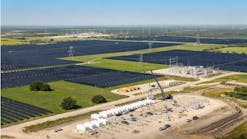The Virtual Power Plant: A New Era of Energy Flexibility
Since the dawn of commercially available light bulbs in the 1880s, electricity has fundamentally changed the world we live in. First there was light. Then there were power plants, alternating current (ac), induction motors, photoelectric cells, nuclear power, wind power, solar power, battery storage, and so forth. The steady march of creative innovation in the electric power industry has transformed life as our ancestors once knew it, to the point that it’s very hard to imagine how we ever existed without electricity.
Just as Edison’s light bulb profoundly changed the status quo by introducing the world to a radically new form of energy, so, too, does the power industry once again find itself on the precipice of dramatic and rapid change. Declining costs of renewable energy have contributed to its double-digit growth, and for the first time this year, the volume of electricity generated by renewable energy in the United States is predicted to surpass that of coal, according to the U.S. Department of Energy (DOE). Major oil companies and large utilities are now among the growing list of influencers embracing global mandates to reduce carbon emissions. Customer demand is burgeoning for more autonomous control over consumption choices as a way to both reduce costs and carbon footprints. It’s a brave new world.
The bottom-line reality is that there is a global and undeniable imperative to transition from a centralized grid made up of a small number of large, traditional power plants to a decentralized, decarbonized grid fed by millions of distributed energy resources (DERs) — from flexible loads, to rooftop solar panels, electric vehicles (EVs), battery storage, smart devices, and much, much more. In fact, GTM Research predicts that distributed resources in the United Sates will double by 2023. While unquestionably a great move for our planet, this transition poses many challenges for utility companies when it comes to grid stability and reliability, as well as economic viability.
Fortunately, we are well on our way to addressing these challenges as the world’s technology innovators and forward-thinking energy companies work together to meet them head on. Oregon’s Portland General Electric (PGE) is a prime example of an energy company that is at the forefront of shaping a smarter and cleaner energy future.
PGE — Achieving Distributed Flexibility at Scale with its Virtual Power Plant
The PGE has aggressive greenhouse gas reduction goals that require major changes to the way it produces, delivers, and uses energy. To meet its energy and climate goals through 2040 and to reduce greenhouse gas emissions by more than 80% by 2050, the electric company’s grid planners concluded that potentially 25% of its load needs to be "flexible" — that is, able to modulate power consumption on demand.
As detailed in the PGE’s deep decarbonization study and integrated resource plan, distributed flexibility is a critical component of the company’s future energy portfolio. With the PGE Virtual Power Plant (VPP), the PGE is really pushing the envelope to demonstrate the benefits of achieving flexibility at scale.
In collaboration with Enbala, the PGE has created a technology agnostic, interoperable VPP that enables control, optimization, and demand management of an entire fleet of DERs across various customers, vendors, and programs. This multi-program, multi-vendor-ecosystem allows for customization across DER asset-types, location, participation schedules, and service offerings, while providing visibility into — and integration of — data to create the smartest and cleanest energy for customers.
According to the PGE’s strategy paper, The Path to a Decarbonized Energy Economy, "We recognize that as customers adopt new clean technologies like EVs, water heaters, and heat pumps, the flexibility of these resources will be increasingly valuable in integrating renewable energy efficiently and affordably. We will develop programs and implement the technologies needed to enhance grid flexibility through the participation of these new electric loads. This will help us make the best use of variable renewable resources, like wind and solar, when they are available, and to reduce costs when they are not."
Leveraging a Large Variety of Distributed Asset Types
The VPP project is on track to add 77 MW of distributed flexibility by the end of 2020 and up to 200 MW by 2025, representing approximately 5% of peak load in both summer and winter seasons. This will include water heaters, thermostats, advanced demand response, behind-the-meter energy storage and EV smart charging. To date, the PGE’s VPP includes over 100 large industrial loads, large commercial loads and small commercial loads, over 150 commercial smart thermostats, and more than 3000 multi-family smart water heaters. By 2020, the PGE will have added over 8000 smart water heaters.
To demonstrate a turnkey microgrid solution, the VPP is currently integrating a combination of solar, storage, and smart thermostats at a City of Portland fire station. Additionally, the PGE’s decarbonization study found that electrifying transportation needs to be a key part of its plan. To that end, the PGE is expecting to integrate 700 commercial EV charging ports and 2500 residential EV charging ports into the VPP by the end of 2021, addressing the critical need for real-time control and optimization of EVs.
In parallel, the PGE has established a Smart Grid Test Bed, which will integrate smart grid technology on a scale never before attempted in the United States. Concentrated in neighborhoods in three Oregon cities, the test bed will be the hub that brings together separate pieces of technology and energy delivery in order to pilot the more integrated grid of the future. The test bed will use the VPP to aggregate, control, and optimize all the flexibility possible in each zone, with the purpose of testing the maximum amount of flexibility that can be harnessed within a given area.
The PGE is also rolling out a time-of-use (TOU) program and a peak time rebate (PTR) program that will target 58,000 customers in 2019. The capacity provided by these programs will be combined with the dispatchable flexibility in the VPP to provide the power operations desk with a single consolidated view of the system flexibility available at any given moment.
Helping Customers with Industry-Leading Innovation
"Knowing that we needed to connect customer value to operational value in a cohesive way, we took a portfolio view of these resources," said the PGE’s manager of distribution resource planning, Josh Keeling. "This is what motivated our VPP approach, as it allows us to look holistically at the panoply of resources, such as flexible loads, smart charging, and energy storage."
According to the PGE’s decarbonization strategy paper, the company is working to help customers adopt clean distributed technologies while integrating them onto the grid, so distributed resources can benefit all customers. To make the most of distributed technologies, the PGE is evolving its processes, from long-term planning to real-time power management operations with the goal of providing an integrated platform that connects customers and their clean energy technologies to the community and to the broader Western energy markets.
In May 2019, the PGE’s innovative VPP project won the Peak Load Management Alliance’s (PLMA) Program Pacesetter award for achieving flexibility at scale, an award that honors industry leaders who created, during calendar year 2018, innovative ideas, methods, programs, and technologies that manage end-use loads to meet peak-load needs and support successful grid integration of DERs.
"By continuing to reduce our emissions through a diverse portfolio of clean and renewable resources — while promoting economy-wide emission reductions through energy efficiency, electrification, and smart energy use — we can help other sectors of the economy to decarbonize and help the state meet its GHG reduction goals," stated the PGE in Our Vision for a Clean and Reliable Energy Future.
According to the PGE’s Keeling, "We’ve been really impressed with the results of our VPP program to date. We’ve seen faster integration and enablement of resources, positive customer feedback, increased realization rates, and overall greater value out of the resource. We look forward to further growth and learnings in the coming years."


